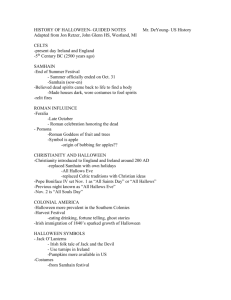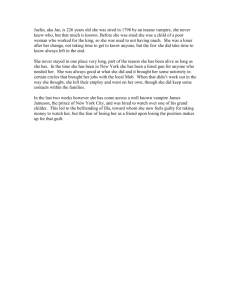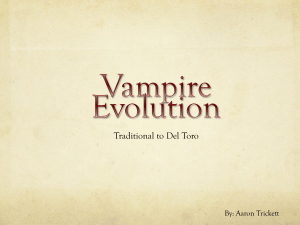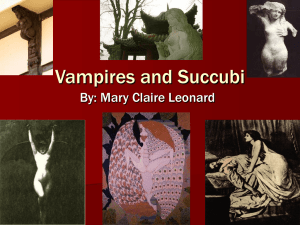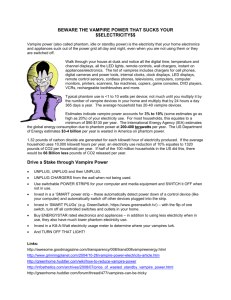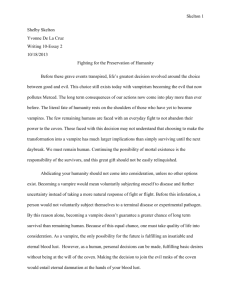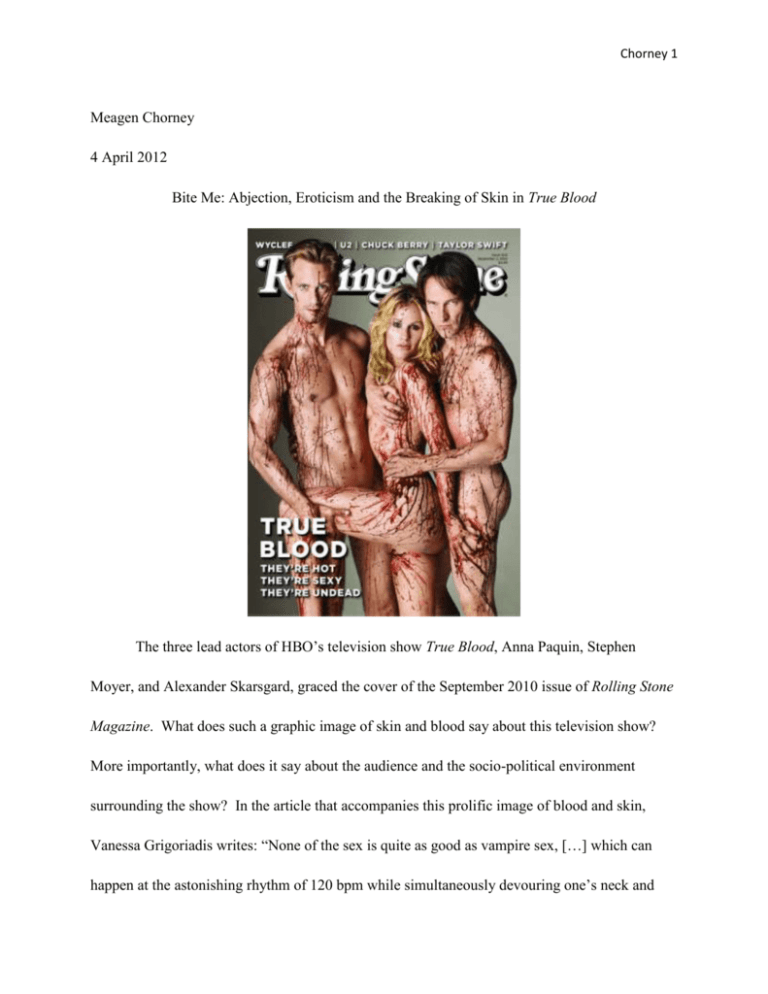
Chorney 1
Meagen Chorney
4 April 2012
Bite Me: Abjection, Eroticism and the Breaking of Skin in True Blood
The three lead actors of HBO’s television show True Blood, Anna Paquin, Stephen
Moyer, and Alexander Skarsgard, graced the cover of the September 2010 issue of Rolling Stone
Magazine. What does such a graphic image of skin and blood say about this television show?
More importantly, what does it say about the audience and the socio-political environment
surrounding the show? In the article that accompanies this prolific image of blood and skin,
Vanessa Grigoriadis writes: “None of the sex is quite as good as vampire sex, […] which can
happen at the astonishing rhythm of 120 bpm while simultaneously devouring one’s neck and
Chorney 2
making your eyes roll back in your head.” Another interview with creator Alan Ball calls True
Blood “the most perverse, and yes, sexiest, show on TV” (Ball). Both articles reflect on True
Blood’s use of not only sex, but violent and (what could be considered) ‘perverse’ sex. I see
‘perverse’ here as falling within the connotation of non-normative sexual acts based on societal
conventions. The skin and blood and implication of a threesome in the Rolling Stone Magazine
cover is significant because it epitomizes the kind of violent and transgressive sexuality that the
show promotes. It is not just about naked skin but about the breaking of that skin; the drawing of
blood from the body. What should be a horrific image (three actors covered in blood) is instead
presented as an appealing, even sexy, image. This image evokes abjection and eroticism, as does
the show.
The vampires of True Blood are accepted by many in the show’s audience. This is
evidenced by fan pages of True Blood on the website Facebook in which fans express their
adoration for these characters. For example, one fan page has over nine million fans (“True
Blood”). Why is this show appealing? How can vampires project an erotic and abject image at
the same time? While it could be argued that the image of a female constantly being bitten by
vampires is derogatory, does True Blood counter this argument in support of female sexuality? I
argue that True Blood shows vampires as abject through the breaking of skin, but also eroticizes
their image to assert female sexuality and the power of choice.
From a phenomenological standpoint, a subject’s relationship to the world is experienced
by the boundary of skin. Skin separates the self from the Other. We can touch the Other, but we
Chorney 3
do not penetrate him or her. A person’s sense of self is determined by his or her proximity yet
distance from others. According to Imogen Tyler, “when the subject/object boundary is
breached, the object is transformed into an abject object” (77). Tyler goes on to say that the
abject is most apparent in “things in or through which the skin border has disintegrated or been
punctured in some way so as to expose the subject to the limits of self” (77). Abjection therefore
occurs at the breaking of skin; the breaking of this boundary between self and Other.
The vampire, more specifically the vampire bite, is the quintessential abject act. The
horrific nature of this act is depicted in scenes such as vampire Eric Northman ripping out the
throat of one of his captives in Season 2. Breaking down this image to the level of skin, the skin
of the captive is broken by Eric’s fangs. The boundary between self (the captive) and Other
(Eric) is breached. A piece of Eric (his fangs) is inside the skin of his captive and his captive’s
blood is inside Eric’s mouth (“Nothing But The Blood”). The boundaries of the two are blurred
in this moment. Shannon Winnubst elaborates on this idea. She states, “The vampire is a
bloodsucker. He sucks blood, transferring an illegitimate and disavowed substance, transforming
his ‘victims’ from the living to the undead, giving birth without sex, trafficking in the strange
and unruly logics of fluids, mixing and spilling and infecting blood” (8).
While the image of Eric Northman and his captive is one just of feeding and killing,
True Blood also incorporates the abject image of a vampire ‘giving birth’ to another vampire. In
Season 1, vampire Bill Compton breaks the skin of Jessica, a young girl, not to feed on her but to
‘give birth’ to her as a vampire (“To Love Is To Bury”). Here the subject/object boundaries are
Chorney 4
not just blurred through the breaking of skin, but the subject is actually changed by the object,
and a bond is created between the two. In True Blood jargon, this makes Bill Jessica’s “maker”
(“To Love Is To Bury”). Stephen Moyer, the actor who plays Bill Compton, acknowledges the
breaking of skin in the show. He is quoted saying, “Vampires create a hole in the neck where
there wasn’t one before. It’s the de-virginization – breaking the hymen, creating blood and then
drinking the vaginal blood. And there’s something sharp, the fang, which is probing and
penetrating and moving into it. So that’s pretty sexy. I think that makes vampires attractive”
(qtd. in Grigoriadis). Moyer’s quote alludes to the ‘sexy’ or erotic appeal of this abject image.
So while the vampire may be the quintessential abject image, the reaction to it is more than just
horror and fascination.
The breaking of skin in True Blood is not just about feeding, killing, or creating new
vampires. True Blood is referred to as sexy because sex is an essential part of the show. Sex
between vampires and humans on True Blood is often accompanied by the vampire biting the
human. Here the breaking of skin is an intimate act. This is best depicted in Season 1 when
Sookie, the lead character of the show, loses her virginity to Bill Compton. During this sex
scene, viewers of the show watch as Bill breaks both the skin and the hymen of his lover and the
boundaries of the two are completely blurred in the mixing of blood and fluids (“Cold Ground”).
While the logistics of breaking skin are the same as the other two scenes I have described, here
the eroticism of the act is highlighted. What should be an abject image is also erotic and
intimate. The vampire as an erotic image is not a far-fetched idea and historically the vampire
Chorney 5
has been eroticized such as the characterization of Dracula. The erotic body is described in an
article by Penelope Deutscher as “existing outside of its imagined limits rather than as enclosed,
as open towards otherness, or permeable, penetrable, vulnerable” (qtd. in Deutscher 151). The
mixing of the erotic and the abject therefore makes sense in that the erotic body is one which is
permeable, penetrable and open towards otherness and the abject object is one which penetrates.
The depiction of a vampire breaking the skin of a human is therefore both abject and erotic.
True Blood capitalizes on the appeal of these abject and erotic images. The fans of the
show must not be forgotten when discussing affective responses (such as abjection and desire).
True Blood fans love the vampires and they love the idea of the vampire bite. As stated in an
interview with Anna Paquin, the actress who plays Sookie, “True Blood clearly taps into the
current vogue for vampires started by the hit film Twilight. […] Its popular appeal is partly that
vampires have a ‘dark, dangerous, brooding sexuality” (Paquin). This point is made even more
apparent by Alexander Skarsgard (the actor who plays Eric Northman), who claims that fans
actually ask him to bite them. He comments, “That’s the one thing I’ll never really understand.
But the main reason I don’t ever do it is because if I do it just once, every single person will be
like ‘Bite me! Bite me! Bite me!’” (qtd. in Haramis).
Looking at these abject and erotic images in True Blood that are so appealing to fans,
such as Bill or Eric biting Sookie, how might these images be interpreted from a third wave
feminist standpoint? More specifically, are female characters being victimized in the show?
Depicting violent sex where the skin of the woman is broken as the (male) vampire bites into her
Chorney 6
neck could be construed as a derogatory image. Following particular strains of second wave
feminism most notable in the 1960s and 1970s, an image of the vulnerable female at the hands of
the powerful male could be read as oppressive to women. Rene Denfield has identified (and
criticized) second wave feminism as “pursuing an agenda based on unswerving belief in female
victimization at the hands of an all-powerful patriarchal system” (qtd. In Gamble, 47). This is
elaborated by Sue Thornham who argues, about mainstream North American cinema, that
“women […] are oppressed within the film industry […]; they are oppressed to being packaged
as images (sex objects, victims, or vampires)” (Thornham, 93). So this begs the question: is
Sookie a victim? My answer to this is no.
The breaking of skin is not so much about the vampire but about the person (woman)
whose skin is being broken. True Blood, it could be argued, is about sexual liberation. I follow
the ideas of many third wave feminist writers who have differed from and often criticized certain
extremist second wave feminists around, as Sarah Gamble explains, “issues of victimization,
autonomy and responsibility” (Gamble, 44). While I do not agree with all criticisms endorsed by
third wave feminists, I too am, as Gamble outlines, “critical of any definition of women as
victims who are unable to control their own lives” (44) and I, too, am also “unable to condemn
pornography” (Gamble 44). Pornographic images are taken up by some feminists as being
damaging to women. Catherine MacKinnon declares that “[t]his definition [of pornography as
the subordination of women] is coterminous with the industry, from Playboy […]through the
torture of women […] to snuff films, in which actual murder is the ultimate sexual act” (qtd. in
Chorney 7
Soble 171). True Blood’s use of sex counters the ideas presented by MacKinnon and is more in
tune with third wave feminist sentiments. When Sookie loses her virginity to Bill, she is
represented as choosing to do so. And she allows him to bite her (“Cold Ground”). When her
bite marks are discovered by her human friends, she defends her choice even though it is an
unpopular one (“Burning House of Love”). Throughout the show, Sookie continues to grow and
assert her ability to choose to engage or not engage in these activities. For example, in Season 3,
she chooses not to engage and bans both vampires (Bill and Eric) from her life (“Evil is Going
On”). Sookie uses a language of choice and does not let vampires dictate her decisions, sexually
or otherwise. This is best exemplified in Season 4 when Eric and Bill try to make the decision
for her not to participate in a fight against the witches that are endangering the vampires and
Sookie declares that it is her choice to put herself in danger. She says “And now maybe you can
both look at me and allow me to speak for myself. I can help” (“Spellbound”).
This language of choice is then taken a step further in the following episode when Sookie
has a very sexually liberating dream, reminiscent of the Rolling Stone cover, in which she
claims that she wants both Bill and Eric together. She declares:
First of all, you guys are vampires, what’s with all the morality? Second of all,
this is such a double standard, when it’s two women and one guy everyone’s
hunky dory with it even if they barely know each other, but when a woman tries
to have her way with two men that she is totally in love with everyone is hemmin’
and hawin’. I’m saying I love you, both of you, and I’m asking you to love me
Chorney 8
back, together. It’s either both of you or nothing at all, take it or leave it. (“Let’s
Get Out of Here”)
Moyer agrees that vampires are a method of sexual liberation for Sookie (qtd. in Grigoriadis).
He goes on to say that “It’s about taking things to the point where normal frames of society
wouldn’t think that was an OK thing for a young Southern girl to do” (qtd. in Grigoriadis). In
another interview, Moyer comments that “it’s about Sookie growing up and making decisions for
herself, rather than being the innocent that she began as. She starts as the innocent virgin, in the
first season, and she’s changed from there. She’s starting to choose what she wants” (Paquin and
Moyer). True Blood acknowledges the sexual liberation of women instead of deploring the
erotic images of them. According to Lynne Segal, new waves of feminists such as postfeminists
and third wave feminists “fear that we risk terminating women’s evolving exploration of our
sexuality and pleasure by forming alliances with, instead of strongly combating, the conservative
anti-pornography crusade” (8).
By making the abject images of vampires and the breaking of skin erotic, True Blood
represents the sexually empowered woman. True Blood shows that it is alright for women to be
sexually liberated, to do something beyond the norm, if that is their choice. Allan Soble argues
that “pornography provides an answer [to what men want] […]: women bound, women battered,
women tortured, women humiliated, women degraded and defiled, women killed” (17). True
Blood depicts this kind of violent sexuality but uses a juxtaposition of choice versus force to
distinguish between what is sexually liberating and what is not. The character of Sookie and her
Chorney 9
language of choice as I have discussed are juxtaposed with the character of Tara in Season 3. In
Season 3, Tara meets a vampire named Franklin and engages in consensual sex with him
(“Beautifully Bound”). Franklin then becomes obsessed with Tara and kidnaps her and
continually rapes and feeds on her (“I Got A Right To Sing The Blues”). In both cases (Sookie
and Tara), the audience is presented with scenes of sex and the biting of a human by a vampire.
The breaking of the skin of Sookie and the breaking of the skin of Tara in these two cases are
represented as very different; that difference being the ability to choose to engage in the act.
This juxtaposition, however, is complicated by racial connotations. Sookie is represented
as a white privileged female and she is juxtaposed with Tara, who is represented as a black,
disenfranchised female dealing with an alcoholic mother. This begs the question, as to who has
the privilege of choice? Sarah Gamble criticizes the assumption that “power is there for the
taking” (Gamble 49). She concludes that “If one is white, middle-class, educated and solvent
American, perhaps; but what if you are black, or poor […]? True Blood, too, shows in this
representation that choice is not ‘there for the taking’ and specific demographics may not have
or, possibly have to work harder for, this privilege.
True Blood also acknowledges that often there is opposition to a woman choosing to
engage in sexually liberating acts, and even goes so far as to villainize this opposition. The
villain of the first season is not the abject vampire or the sexually liberated woman who engages
with him, but a murderer who is killing what the show calls ‘fangbangers,’ women who choose
to have sex with vampires (“You’ll Be The Death of Me”). The villain specifically focuses on
Chorney 10
women who engage with male vampires but True Blood uses a multitude of human /vampire
pairings to show that the human female/vampire male pairing is not exclusive. True Blood uses
a blurring of female vampires biting both males and females, and male vampires biting both
males and females to reinforce that these images are not about the powerful male preying on the
vulnerable female.
True Blood not only blurs the boundaries of self and Other, abject and erotic but also the
boundaries of what is sexually ‘normal.’ Through the character of Sookie, a language of choice
is developed in which ‘acceptable sexuality’ is dictated by the individual not the society. The
breaking of skin in True Blood signifies both the biter and the individual being bitten and for the
individual choosing to be bitten, it can be a conscious mark of sexual liberation.
Chorney 11
Works Cited
Ball, Alan. “Interview: Alan Ball Talks ‘True Blood’, Vampire Sex, and Sookie’s HipHop Cred.” Complex 23 June 2011. Web. 29 Oct. 2011.
“Beautifully Bound.” True Blood. HBO. 20 June 2010. Television.
“Burning House of Love.” True Blood. HBO. 19 Oct. 2008. Television.
“Cold Ground.” True Blood. HBO. 12 Oct. 2008. Television.
Deutscher, Penelope. “Three touches to the skin and one look: Sartre and Beauvoir on
desire and embodiment.” Thinking Through the Skin. Ed. Ahmed, Sara, and Jackie
Stacey. New York: Routledge, 2001. 143-159. Print.
“Evil Is Going On.” True Blood. HBO. 12 July 2010. Television.
Gamble, Sarah. “Postfeminism.” The Routledge Companion to Feminism and Postfeminism.
Ed. Gamble, Sarah. London: Routledge, 2004. 29-42. Print.
Grigoriadis, Vanessa. “The Joy of Vampire Sex: The Schlocky, Sensual Secrets Behind
the Success of ‘True Blood.’” Rollingstone.com 2 Sept. 2010. Web. 29 Oct. 2011.
Haramis, Nick. “First a Vampire, Now a Leading Man: Alexander Skarsgard can’t be
tamed.” Blackbook 15 Sept. 2011. Web. 29 Oct. 2011.
“I Got A Right To Sing The Blues.” True Blood. HBO. 25 July 2011. Television.
“I Wish I Was The Moon.” True Blood. HBO. 31 July 2011. Television.
“Let’s Get Out Of Here.” True Blood. HBO. 21 Aug. 2011. Television.
“Nothing But The Blood.” True Blood. HBO. 14 June 2009. Television.
Paquin, Anna. “Anna Paquin: Interview for ‘True Blood’.” The Telegraph 5 Oct. 2009.
Web. 29 Oct. 2011.
Paquin, Anna, and Stephen Moyer. “Anna Paquin and Stephen Moyer Interview TRUE
Chorney 12
BLOOD Season 4.” collider.com 1 Aug. 2011. Web. 29 Oct. 2011.
Segal, Lynne. “Does Pornography Cause Violence? The Search for Evidence.” Dirty Looks:
Women, Pornography, Power. Ed. Church Gibson, Pamela, and Roma Gibson. London:
BFI Publishing, 1993. 1-4. Print.
Soble, Allan. Pornography, Sex and Feminism. New York: Prometheus Books, 2002.
Print.
“Spellbound.” True Blood. HBO. 14 Aug. 2011. Television.
Thornham, Sue. “Feminism and Film.” The Routledge Companion to Feminism and
Postfeminism. Ed. Gamble, Sarah. London: Routledge, 2004. 80-92. Print.
“To Love Is To Bury.” True Blood. HBO. 16 Nov. 2008. Television.
“True Blood.” facebook.com Facebook, 2011. Web. 1 Dec. 2011.
Tyler, Imogen. “Skin-tight: celebrity, pregnancy and subjectivity.” Thinking Through the Skin.
Ed. Ahmed, Sara, and Jackie Stacey. New York: Routledge, 2001. 69-84. Print.
Winnubst, Shannon. “Vampires, Anxieties, and Dreams: Race and Sex in the
Contemporary United States.” Hypatia 18.3 (Summer 2003): 1-20. Project
Muse. Web. 29 Oct. 2011.
“You’ll Be The Death Of Me.” True Blood. HBO. 23 Nov. 2008. Television.
Image
Rolston, Matthew. True Blood: They’re Hot. They’re Sexy. They’re Undead. 2 Sept. 2010.
rollingstone.com Web. 1 Dec. 2011.


